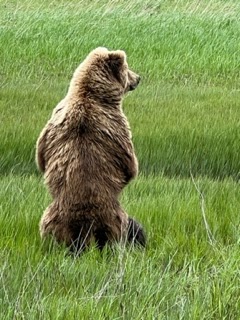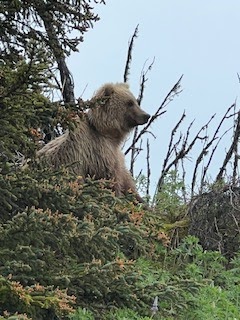The experience at Silver Salmon Creek Lodge was fabulous. Our guide Brooke loves the bears, and watching them go about their day, playing, foraging, mothering, watching you watching them, you couldn’t help but fall in love a little bit too. There is a distinction between grizzlies and brown bears here. I read up a little more, and here’s what I learned.
Alaska is home to 98% of America’s grizzly bear population and more than 70% of the population in North America. They get their name from the “grizzled” (streaked) blond-tipped fur on their shoulders and back. Brown and grizzly bears are classified as the same species even though there are differences between them, most notably location. Brown bears typically live along the southern coast of the state where they have access to seasonally abundant, fat-rich salmon, as well as clams, sedge grass and other vegetation. In contrast, their grizzly cousins, living in the northern and interior parts of the state and lacking the bountiful salmon runs, forage mostly on grasses, berries, roots, trout from streams, and they will prey upon moose and elk calves. But because the bulk of their diet is vegetarian, they are smaller than the browns living on the coast. Coastal brown bears and polar bears are actually the largest bears in the world. At peak body condition, boars (males) from interior areas may weight up to 600 pounds while boars from coastal areas may reach 1,500 pounds. Sows (females) usually weigh half the weight of males in any region.
In addition to variations in size, inland grizzlies seem to act more aggressively towards other bears and humans, most likely due to a less abundant food supply and the need for a more extensive home range. Brooke explained the abundant food supply and 40+ years of non threatening bear viewing in this part of the park is what allows the bears to go about their activities with humans and other bears so near.
We saw the Three Amigos, three young bears who enjoyed hanging out together; we watched Crimp Ear with her two cubs making their first appearance before humans, and they were curious about us; Cub Killer, a big boar whose name is self-explanatory, was spotted multiple times; and Little Davy, a three-year old named in honor of one of the lodge guides who had been away from the park for months and was missed by his friends. And others. Altogether we saw 12-15 different bears. We watched them playing/wrestling, lying on their backs stretching (so funny!), a cub’s hissy fit when he wanted to nurse and mama in no uncertain terms telling him “not now!”, lots of vegetation chewing, Cub Killer, with mating on his mind, stalking the sows and multiple bears on the beach digging for clams. How do they know where to dig? With their keen sense of smell, they can smell them buried in the sand!
It was amazing to be in their space.















.jpg)

No comments:
Post a Comment